CLT design
After introducing the stiffness behaviour of CLT plates in version 22, it is now possible in SCIA Engineer 22.1 to fully design and check CLT plates. The new 2D ultimate limit state check for CLT panels is complete with many options for visual display of results and a detailed formula output.
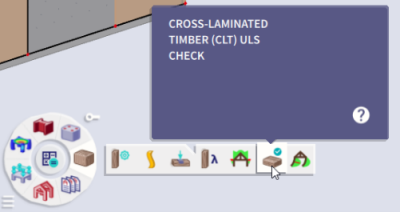
The check works like the checks for other materials. You will find the icon in the timber menu, or it can simply be looked up in SCIA Spotlight. There are two prerequisites to run the check:
- the plate needs to be of a CLT type wood material,
- the plate needs to have a CLT orthotropy assigned to it.
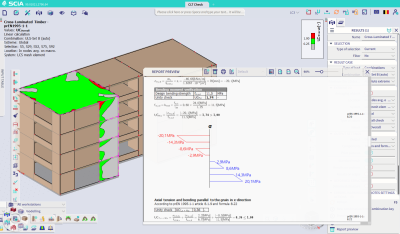
The design is performed according to the draft of the second generation of Eurocodes prEN 1995-1-1. Thanks to the calculation of the orthotropy, the analysis returns the internal forces acting in the CLT plates. In the checks, these internal forces are transformed into stresses per layer and verified. The following checks are executed:
- tension parallel to the grain,
- compression parallel to the grain,
- bending,
- axial tension and bending,
- axial compression and bending,
- transverse shear,
- in-plane shear,
- torsion and combined Shear and torsion,
- flexural buckling.
For every check a detailed output with formulas and references to the relevant parts of the code can be displayed. Additionally, you can graphically display the stress distribution in the plate layers.
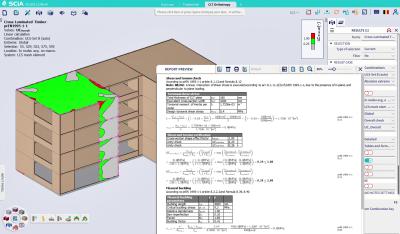
Timber SLS design improvements
SCIA Engineer 22.1 brings you an upgraded timber SLS check. The check now offers many new functionalities and additional output options, as well as a simplified input for deflection limits.
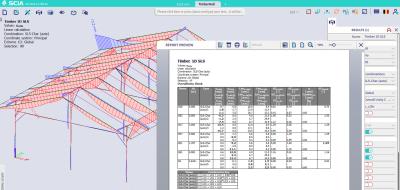
In the timber setup, you can define the default limits for the instant, final and net final deflections and choose whether you want to design, or manually input the camber on the structure.
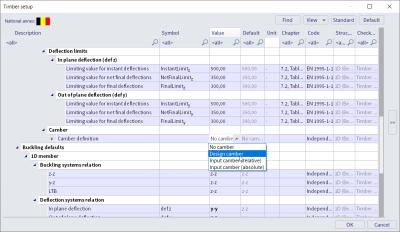
In the buckling settings, you can overwrite those default settings for specific beams, if desired. For cantilevers, a correction factor of 2 is automatically applied to the defined limits.
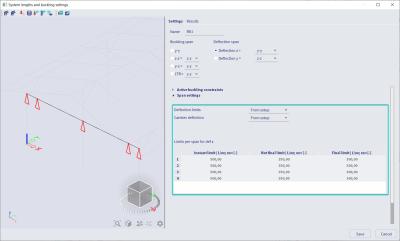
For the output of the check, you can select values that will be displayed both graphically and in tabular form.
Column design using 2nd order
The nominal stiffness method according to EC2 §5.8.8 has been added to SCIA Engineer to determine more accurately the second-order effect on highly-reinforced slender columns, making it a better alternative to the existing nominal curvature method. This option can be selected globally via Concrete setup or changed individually per member via Concrete member data.
Obtained 2nd order moments from both simplified methods can be also further enhanced by considering a load duration using the effective creep ratio (EC2 Eq. 5.19). Newly, it’s possible to manually input Mqp/Med ratio in the global Concrete settings to define the effective creep coefficient. To ensure full compliance with Eurocode 2, we've also automated the neglecting of the creep effect when code-based conditions are met according to EC2 §5.8.4(4).
Overall, these improvements result in a more economical design while still meeting all necessary requirements, making it a valuable addition to your software toolset.
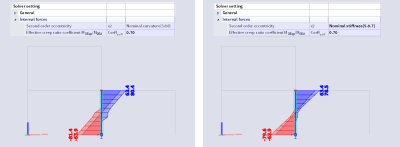
Recalculation of rib axial force
One of the great features of SCIA Engineer related to ribs is the possibility to neglect the axial force in the design/checks by recalculation of this effect to an additional bending moment. As a result, further calculations can be performed using the design bending moment only. To improve the transparency and clarity of this procedure, a few improvements have been implemented to always receive results comparable with a simplified 1D model analysed according to a beam theory.
The normal force is now recalculated also for the axial force in compression to ensure compatible results of the design moments above supports. Moreover, the alignment of the ribs above the slabs is now correctly taken into account to see the distribution of the recalculated bending moments in the same manner as for ribs below the slab.
The last factor playing a significant role in the axial force recalculation is a different input of effective width for the integration of internal forces and for the cross-section used in design and code-checks. Firstly, this discrepancy can now be seen directly in the 3D scene because the cross-section shape of the rib is drawn using the effective width for the checks. And secondly, the correct eccentricity for the axial force recalculation is taken from the effective width for the integration of internal forces, which means that for any input of effective widths the same results are obtained.
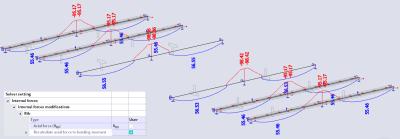
Bill of material with 2D reinforcement
To get a complete overview of practical reinforcement within the model, the Bill of material command was extended by user-defined reinforcement from selected 2D members. Both reinforcement meshes and free bars are taken into account. It’s possible to use sorting by reinforcement material or by diameter. There is also an option to manually increase the amount of reinforcement due to overlapping and detailing.

Minimum reinforcement on slabs
To extend the control over the definition of minimum reinforcement in slabs, two new options ‘Whole member’ and ‘In tension area only’ have been added to the Detailing provision chapter in the Concrete setup/member data (Eurocode). This specifies whether the minimum reinforcement area is generated on the entire surface of the 2D member or only in places where the calculated required reinforcement area is greater than zero (i.e. only in those finite elements where tension occurs in a given layer).
This leads to greater flexibility in the reinforcement design for planar elements, especially in determining how the provided reinforcement from the design template is eventually distributed.
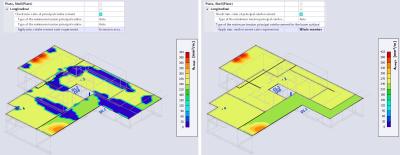
Actions in supports (formerly Foundation Table)
SCIA Engineer 22.1 makes it possible to generate a comprehensive table with the actions (both forces and moments) the superstructure transmits to nodal supports.
The table generated by the “Action on supports” command contains actions (forces and bending moments) for each node and each load cases. It can be displayed in the report Preview, in Engineering Report and also in the Table Results from where it can be exported to MS Excel by a single click.
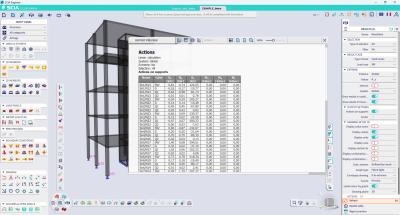

Improved licence settings
Scia Engineer version 22.1 brings some improvements needed since the migration to our latest cloud licence system, to make your use of SCIA Engineer smoother.
Access settings on startup
First of all, the licence settings are available upon startup when no licence is available. An available licence can be selected or the user can be switched before opening the application.

Selection of licences
Through the same familiar menu, the improved licence settings dialog can be opened. It shows mandatory, optional and unavailable licences. This allows you:
• To identify the mandatory licences from which you need to at least select one to continue.
• To identify the available and unavailable licences.
• To make a custom selection of optional and unavailable licences. This way they can be intentionally used as soon as they are available. Or they can be deselected which makes the licences available for colleagues at any time, preventing overuse of the licences
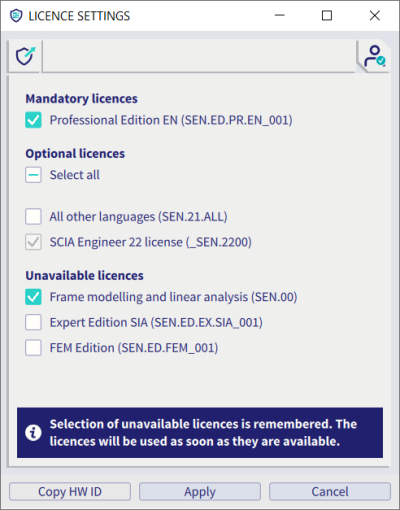
The warnings in the dialog will guide you through the process of making a licence selection and applying it.
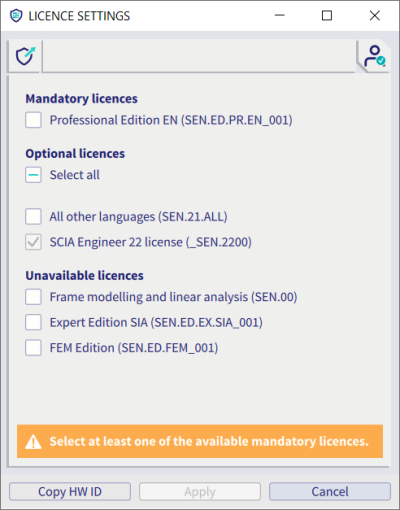
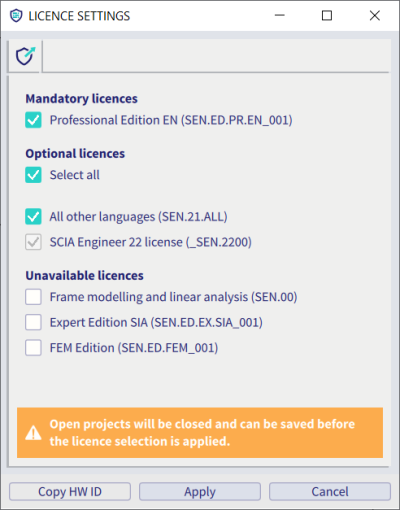
Additional functionalities
From the header, you can be directed to the cloud portal for organizations to see the licence use in the company, or you can switch users.
Improved mechanisms
Only the selected licences are remembered by default, which means that new modules in the licence pool will not be selected and taken in use automatically.
Mandatory licences are identified and remembered, so these items are always displayed in the mandatory section.

Want to try SCIA Engineer yourself?
Explore how our software and services can help you optimise your work and boost your productivity. Try it for yourself with a free 30-day software trial.
Download a free 30-days full trial